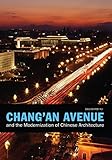Chang'an Avenue and the modernization of Chinese architecture [electronic resource] / Shuishan Yu.
Material type: TextSeries: China Program bookPublication details: Seattle : University of Washington Press, 2012Edition: 1st edDescription: xiii, 351 p. : ill., plansISBN: 9780295804484 (electronic bk.)Subject(s): Symbolism in architecture -- China -- Beijing | City planning -- China -- Beijing | Architecture and state -- China -- Beijing | Chang'an Jie (Beijing, China) | Beijing (China) -- Buildings, structures, etcGenre/Form: Electronic books.DDC classification: 720.951/156 LOC classification: NA9053.S7 | Y8 2012Online resources: Click to View
TextSeries: China Program bookPublication details: Seattle : University of Washington Press, 2012Edition: 1st edDescription: xiii, 351 p. : ill., plansISBN: 9780295804484 (electronic bk.)Subject(s): Symbolism in architecture -- China -- Beijing | City planning -- China -- Beijing | Architecture and state -- China -- Beijing | Chang'an Jie (Beijing, China) | Beijing (China) -- Buildings, structures, etcGenre/Form: Electronic books.DDC classification: 720.951/156 LOC classification: NA9053.S7 | Y8 2012Online resources: Click to View Outgrowth of the author's thesis (Ph.D.--University of Washington).
Includes bibliographical references and index.
The History of Chang'an Avenue in an Urban Context -- National versus Modern: The 1950s -- Collective Creation: The 1964 Chang'an Avenue Planning -- Modernization in a Postmodern World: The 1970s and 1980s -- Collage without Planning: Toward the New Millennium -- Chang'an Avenue and the Axes of Beijing -- Conclusion: Chang'an Avenue in a Global Context.
"In this interdisciplinary narrative, the never-ending "completion" of China's most important street offers a broad view of the relationship between art and ideology in modern China. Chang'an Avenue, named after China's ancient capital (whose name means "Eternal Peace"), is supremely symbolic. Running east-west through the centuries-old heart of Beijing, it intersects the powerful north-south axis that links the traditional centers of political and spiritual legitimacy (the imperial Forbidden City and the Temple of Heaven). Among its best-known features are Tiananmen Square and the Great Hall of the People, as well as numerous other monuments and prominent political, cultural, financial, and travel-related institutions. Drawing on Chang'an Avenue's historic ties and modern transformations, this study explores the deep structure of the Chinese modernization project, providing both a big picture of Beijing's urban texture alteration and details in the design process of individual buildings.Political winds shift, architectural styles change, and technological innovations influence waves of demolition and reconstruction in this analysis of Chang'an Avenue's metamorphosis. During collective design processes, architects, urban planners, and politicians argue about form, function, and theory, and about Chinese vs. Western and traditional vs. modern style. Every decision is fraught with political significance, from the 1950s debate over whether Tiananmen Square should be open or partially closed; to the 1970s discussion of the proper location, scale, and design of the Mao Memorial/Mausoleum; to the more recent controversy over whether the egg-shaped National Theater, designed by the French architect Paul Andreu, is an affront to Chinese national pride.Shuishan Yu is associate professor of art history at Oakland University in Rochester, Michigan."-- Provided by publisher.
Electronic reproduction. Ann Arbor, MI : ProQuest, 2015. Available via World Wide Web. Access may be limited to ProQuest affiliated libraries.


There are no comments on this title.